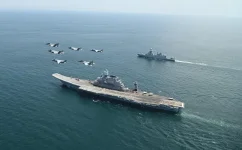- Views: 1K
- Replies: 14
The procurement process for essential heavyweight torpedoes (HWT) for the Indian Navy's Kalvari-class submarines has entered a decisive phase.
Italy's Black Shark torpedo, produced by Leonardo Electronics, is now considered the primary option after Germany’s ThyssenKrupp Marine Systems (TKMS) unexpectedly withdrew from the competition, as reported by The Economic Times on April 15, 2025.
The tender aims to acquire 48 advanced HWTs to arm India's modern submarine fleet.
The withdrawal of TKMS, which was anticipated to offer its Atlas Elektronik SeaHake torpedo, significantly alters the competitive landscape. While France's Naval Group remains in contention, likely proposing its F21 torpedo, sources indicate its offer might be more expensive.
This potentially gives the Italian Black Shark a significant advantage based on cost, aligning with India's defence procurement strategy that balances advanced capabilities with financial prudence.
The Indian Navy's previous experience with the Black Shark during earlier evaluation phases also contributes to its current favourable position.
However, the Black Shark torpedo comes with a complicated history. It was previously selected around 2008-09 for a larger order of 98 torpedoes intended for the same Kalvari-class submarines, which are constructed by Mazagon Dock Shipbuilders Limited (MDL) in partnership with Naval Group.
That procurement effort was halted in 2013 amid allegations of irregularities. India's Ministry of Defence (MoD) subsequently referred the matter to the Central Bureau of Investigation (CBI).
Furthermore, the torpedo's original parent company, then part of the Finmeccanica group (now rebranded as Leonardo), faced scrutiny related to the separate AgustaWestland VVIP helicopter deal, casting a shadow over the torpedo's re-emergence.
Despite these past controversies, the Black Shark's return as a leading contender in 2025 signals a pragmatic approach by India to meet urgent operational requirements.
The torpedo itself is a sophisticated 533 mm HWT designed for effectiveness against both submarines (anti-submarine warfare - ASW) and surface ships (anti-surface warfare - ASuW).
It employs advanced guidance systems, including wire guidance and autonomous homing features, utilizing a multi-mode seeker combining active and passive sonar.
With reported speeds exceeding 50 knots and a range surpassing 50 kilometres, the Black Shark meets the demanding performance criteria for operations within the Indian Ocean Region (IOR).
The Kalvari-class submarines represent a significant enhancement to India's underwater combat capabilities. Based on the French Scorpene design, five of the six planned submarines are already commissioned, with the final one undergoing sea trials.
These submarines feature the advanced SUBTICS (Submarine Tactical Integrated Combat System) and possess the capacity to carry a mix of 18 weapons, including both torpedoes and anti-ship missiles.
Equipping these platforms with a capable HWT like the Black Shark is crucial for maintaining a credible deterrent and effectively countering potential underwater and surface threats from adversaries, including the growing naval presence of China in the IOR.


